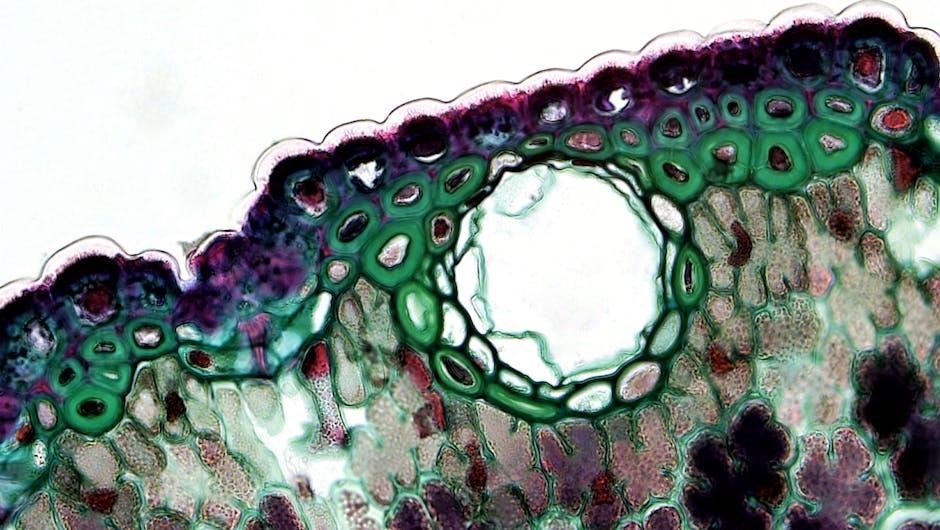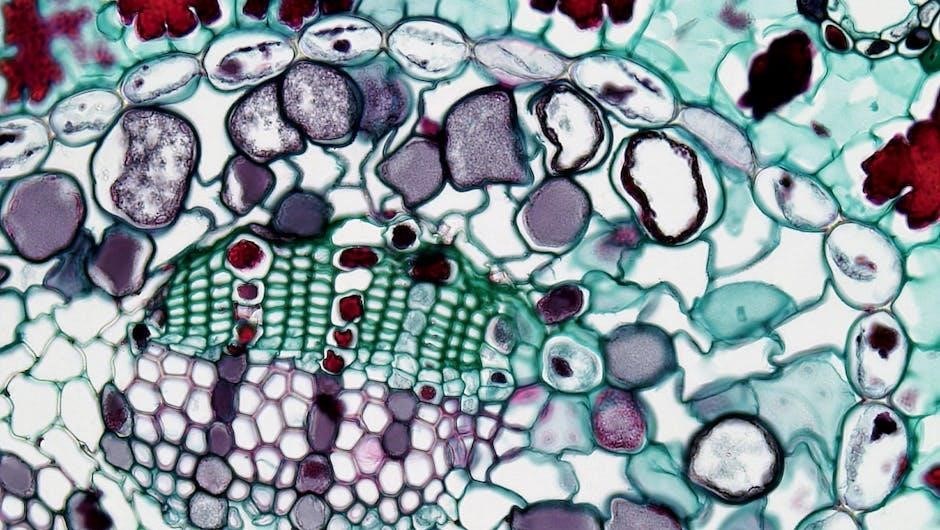
Cellular respiration and photosynthesis are vital biological processes that sustain life on Earth. They involve energy conversion, with photosynthesis producing glucose using sunlight and respiration breaking it down to release energy. Understanding these processes is essential for grasping how life functions at the cellular level.
Cellular respiration is a fundamental biological process that occurs in cells, enabling organisms to convert glucose into energy in the form of ATP (adenosine triphosphate). This process is essential for both autotrophs (e.g., plants and algae) and heterotrophs (e.g., animals and fungi), as it provides the energy required for cellular functions. Cellular respiration can occur in two main forms: aerobic respiration, which requires oxygen, and anaerobic respiration, which does not.
Aerobic respiration is a highly efficient process that involves three main stages: glycolysis, the Krebs cycle, and the electron transport chain. Together, these stages produce a total of 36 ATP molecules from a single glucose molecule. Anaerobic respiration, on the other hand, is less efficient, producing only 2 ATP molecules per glucose molecule. It is typically observed in environments where oxygen is scarce.
Cellular respiration is closely linked to photosynthesis, as both processes involve the exchange of oxygen and carbon dioxide. While photosynthesis produces glucose using sunlight, cellular respiration breaks it down to release energy. This interplay underscores the interconnectedness of life on Earth, where energy flows through ecosystems via these two processes.
Understanding cellular respiration is crucial for grasping how cells function, how energy is produced, and how life sustains itself. This section provides a foundational overview of the process, paving the way for deeper exploration of its mechanisms and significance.

Photosynthesis is a vital biological process carried out by autotrophic organisms such as plants, algae, and some bacteria. It is the process by which these organisms convert sunlight into chemical energy in the form of sugars, which are used to fuel their metabolic activities. This process occurs primarily in specialized organelles called chloroplasts, where the pigment chlorophyll plays a central role in absorbing light energy.
The basic equation for photosynthesis is:

6CO₂ + 6H₂O + light energy → C₆H₁₂O₆ (glucose) + 6O₂
Photosynthesis is essential for life on Earth, as it provides the oxygen necessary for cellular respiration in heterotrophs and serves as the primary source of energy for food chains. Without photosynthesis, the energy flow through ecosystems would cease, making life as we know it impossible.
Chlorophyll, embedded in the thylakoid membranes of chloroplasts, absorbs light energy, particularly in the blue and red wavelengths, and reflects green light, giving plants their characteristic color. This energy is then used to drive the conversion of carbon dioxide and water into glucose and oxygen.
Understanding photosynthesis is fundamental to appreciating how life sustains itself and how ecosystems function. This section provides an overview of the process, setting the stage for a deeper exploration of its mechanisms and significance.
The Process of Cellular Respiration
Cellular respiration is the process by which cells break down glucose to produce energy in the form of ATP (adenosine triphosphate). This metabolic process is essential for life, as it provides the energy required for various cellular functions.
There are three main stages of cellular respiration: glycolysis, the Krebs cycle, and the electron transport chain. Glycolysis occurs in the cytoplasm and does not require oxygen, breaking down one glucose molecule into two pyruvate molecules, producing a small amount of ATP and NADH.
The Krebs cycle takes place in the mitochondrial matrix and requires oxygen. It further breaks down the pyruvate molecules into acetyl-CoA, producing more ATP, NADH, and FADH₂ as byproducts. The electron transport chain, located in the inner mitochondrial membrane, uses these molecules to generate a proton gradient, driving the production of the majority of ATP through oxidative phosphorylation.
In total, one glucose molecule yields approximately 36-38 ATP molecules under ideal conditions. Cellular respiration is a catabolic process, releasing energy stored in glucose for cellular use. This process is vital for sustaining life, as it powers the metabolic activities of cells.
The Process of Photosynthesis
Photosynthesis is the biological process by which plants, algae, and some bacteria convert sunlight, carbon dioxide, and water into glucose and oxygen. This process is essential for life on Earth, as it provides the oxygen necessary for respiration and the organic molecules that serve as energy sources for food chains.
Photosynthesis occurs in specialized organelles called chloroplasts and involves two main stages: the light-dependent reactions and the Calvin cycle. The light-dependent reactions take place in the thylakoid membranes and use chlorophyll, a green pigment, to absorb light energy. This energy is used to produce ATP and NADPH, which are then utilized in the Calvin cycle.

The Calvin cycle occurs in the stroma of the chloroplast and involves the fixation of carbon dioxide into glucose using the ATP and NADPH produced earlier. This cycle is catalyzed by the enzyme RuBisCO and results in the production of glucose, which can be used by the plant or other organisms for energy.
Environmental factors such as light intensity, temperature, and carbon dioxide concentration significantly influence the rate of photosynthesis. Understanding these factors is crucial for optimizing plant growth and agricultural productivity. Photosynthesis is a cornerstone of life, supporting ecosystems and enabling the energy flow that sustains all living organisms.
Key Molecules in Cellular Respiration
Cellular respiration involves several key molecules essential for energy production. Glucose is the primary substrate, broken down to release energy. Oxygen acts as the final electron acceptor in the electron transport chain, enabling the generation of ATP. ATP itself is a critical energy carrier, produced in abundance during respiration.
NADH and FADH2 are electron carriers that transport electrons during the process, vital for ATP synthesis. Water participates as both a reactant and product, particularly in the Krebs cycle and electron transport chain. Carbon dioxide is a waste product, released into the atmosphere.
Enzymes catalyze the reactions, accelerating the process for cellular needs. The inner mitochondrial membrane is crucial for the electron transport chain, facilitating ATP production through chemiosmosis. Each molecule plays a distinct role, interacting to sustain energy production in cells.
Understanding these molecules’ roles and interactions is fundamental to comprehending cellular respiration’s efficiency and necessity for life.
Key Molecules in Photosynthesis
Photosynthesis relies on several key molecules to convert sunlight into energy. Chlorophyll, a green pigment in chloroplasts, absorbs light energy, particularly in the blue and red wavelengths, driving the process. Other pigments like carotenoids assist in light absorption and protection from oxidative damage.
ATP and NADPH, produced in the light-dependent reactions, are essential for the Calvin cycle, where CO2 is fixed into glucose. Water is a critical reactant, providing oxygen and hydrogen atoms. Oxygen is released as a byproduct of water splitting in the thylakoid membranes.
The thylakoid membrane itself is vital, housing pigment-protein complexes and the machinery for ATP synthesis. In the Calvin cycle, RuBisCO catalyzes CO2 fixation, a cornerstone of carbon assimilation. Enzymes like RuBisCO and ATP synthase are indispensable, ensuring efficiency and regulation of the process.
Chlorophyll and accessory pigments work together to maximize light absorption, while ATP and NADPH provide the energy and reducing power needed for glucose synthesis. Understanding these molecules’ roles is crucial for grasping how photosynthesis sustains life on Earth.

Environmental Factors Affecting Photosynthesis
Photosynthesis is influenced by several environmental factors that impact its efficiency and rate. Light intensity is a primary factor, as it directly affects the light-dependent reactions. Low light conditions reduce ATP and NADPH production, slowing down the Calvin cycle. Conversely, excessive light can lead to photoinhibition, damaging chlorophyll and reducing photosynthetic activity.
Temperature also plays a critical role. Enzymes involved in photosynthesis, such as RuBisCO, function optimally within a specific temperature range. High temperatures can denature enzymes, while low temperatures slow down metabolic processes. Additionally, CO2 concentration is essential, as it directly affects the Calvin cycle. Low CO2 levels limit glucose production, while high levels can enhance it, up to a point.

Water availability is another key factor. Drought conditions lead to stomatal closure, reducing CO2 intake and limiting photosynthesis. Pollution, such as sulfur dioxide, can damage chloroplasts and impair photosynthetic pigments. Seasonal changes in daylight and temperature also influence photosynthetic activity, affecting plant growth cycles.
Understanding these environmental factors is crucial for optimizing plant growth and addressing challenges like climate change. By studying how these variables interact, scientists can develop strategies to enhance photosynthetic efficiency and improve agricultural productivity.
Comparing and Contrasting Respiration and Photosynthesis
Cellular respiration and photosynthesis are two fundamental biological processes that are intricately linked. While photosynthesis occurs in chloroplasts of plant cells and some algae, cellular respiration takes place in the mitochondria of most living organisms. Both processes involve energy transformation, but their purposes differ; Photosynthesis captures light energy to produce glucose, whereas respiration breaks down glucose to release energy.
A key similarity is the involvement of ATP, which is both produced in respiration and consumed in photosynthesis. Both processes also involve electron transport chains, though their specific mechanisms and locations differ. However, the stages are distinct: photosynthesis includes the light-dependent reactions and Calvin cycle, while respiration comprises glycolysis, the Krebs cycle, and oxidative phosphorylation.
Another contrast lies in their ecological roles. Photosynthesis is an anabolic process, building organic molecules, while respiration is catabolic, breaking them down. Oxygen is a byproduct of photosynthesis and a reactant in respiration, highlighting their interdependence in maintaining life on Earth. Despite these differences, both processes are essential for the energy balance in ecosystems.
Understanding their comparison aids in appreciating how life sustains itself through these interconnected cycles. These processes underscore the delicate balance of nature and the importance of energy conversion in biological systems.
Practical Applications and Experiments
Understanding cellular respiration and photosynthesis opens doors to numerous practical applications and experimental opportunities. One key application is in agriculture, where optimizing photosynthesis can enhance crop yields. By manipulating environmental factors like light intensity, CO2 levels, and temperature, farmers can maximize plant growth and productivity.
In scientific research, experiments often involve measuring the rates of respiration and photosynthesis. For instance, scientists use oxygen sensors to track O2 release during photosynthesis or consumption during respiration. Similarly, carbon dioxide exchange can be monitored to study how environmental changes impact these processes.
Lab experiments, such as observing the effects of light intensity on photosynthesis using aquatic plants, provide hands-on learning. Students can measure oxygen production using probes or count bubbles released by submerged plants under different light conditions. These activities help visualize the interplay between light, chlorophyll, and energy production.
Another practical application is in biofuel production, where cellular respiration in microorganisms is harnessed to convert organic matter into energy sources like ethanol. Additionally, studying the electron transport chain in respiration has inspired advancements in energy-efficient technologies.
These experiments and applications highlight the real-world relevance of cellular respiration and photosynthesis, offering insights into improving agricultural practices, developing sustainable energy solutions, and understanding ecological systems.

Cellular respiration and photosynthesis are fundamental biological processes that underpin life on Earth. Photosynthesis converts light energy into chemical energy, producing oxygen and glucose, while cellular respiration breaks down glucose to release energy, forming CO2 and water. These processes are interdependent, sustaining ecosystems and supporting energy flow in living organisms.
Key takeaways include understanding the stages of cellular respiration—glycolysis, the Krebs cycle, and the electron transport chain—which collectively produce 36 ATP molecules per glucose molecule. In photosynthesis, light-dependent reactions generate ATP and NADPH, enabling the Calvin cycle to produce glucose. Environmental factors like light intensity, CO2 levels, and temperature significantly influence photosynthesis efficiency.
Practical applications of these processes are vast, from optimizing crop yields in agriculture to advancing biofuel production. Experiments, such as measuring oxygen release or CO2 absorption, provide hands-on insights into these mechanisms. Grasping these concepts is essential for understanding life’s energy dynamics and addressing global challenges like food security and sustainable energy.